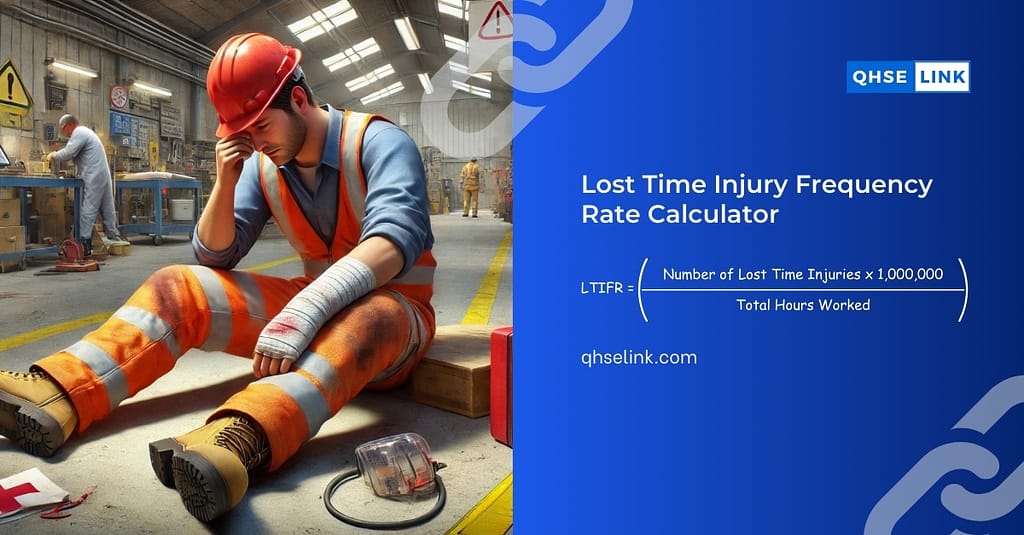Lost Time Injury Frequency Rate (LTIFR) Calculator
The Lost Time Injury Frequency Rate (LTIFR) is a standard safety metric that quantifies the number of lost time injuries occurring per one million hours worked within an organization. It serves as a benchmark to assess the effectiveness of safety programs and protocols in place.
Understanding Lost Time Injuries
Lost time injuries are incidents that result in an employee being unable to perform their regular work duties for a certain period. Examples include fractures, severe sprains, or any injury necessitating time off work. These injuries not only affect the well-being of employees but also impact organizational productivity and morale.

The Significance of LTIFR in Occupational Health
LTIFR plays a pivotal role in evaluating an organization’s safety performance. A lower LTIFR indicates fewer injuries and a safer work environment, while a higher LTIFR may signal underlying safety issues that need addressing. Organizations often use LTIFR to benchmark their safety performance against industry standards, facilitating continuous improvement.
How to Calculate Lost Time Injury Frequency Rate (LTIFR)
The formula to calculate LTIFR is:

For instance, if a company reports 5 lost time injuries and has accumulated 2,000,000 total hours worked, the LTIFR would be:
LTIFR = (5 × 1,000,000) ÷ 2,000,000 = 2.5
This result signifies that there are 2.5 lost time injuries per one million hours worked.
Components of the LTIFR Formula
- Number of Lost Time Injuries: Total count of incidents resulting in employees missing work.
- Total Hours Worked: Cumulative number of hours worked by all employees during a specific period.
- Multiplication Factor (1,000,000): Standardizes the rate per one million hours worked, allowing for consistent benchmarking.
Utilizing the LTIFR Calculator
Our LTIFR Calculator is designed for ease of use:
- Input the Number of Lost Time Injuries: Enter the total incidents recorded.
- Enter Total Hours Worked: Provide the cumulative hours worked by the workforce.
- Calculate: The calculator will automatically compute the LTIFR based on the provided data.
This tool streamlines the calculation process, ensuring accuracy and efficiency.
Interpreting LTIFR Results
Upon obtaining the LTIFR, organizations should analyze the results in the context of their industry standards and historical data. A decreasing LTIFR trend over time typically reflects improvements in safety measures, whereas an increasing trend may necessitate a review of current safety protocols.
Benefits of Monitoring LTIFR
Regular monitoring of LTIFR offers several advantages:
- Identifying Safety Trends: Recognize patterns that may indicate emerging safety concerns.
- Implementing Proactive Measures: Address potential hazards before they result in injuries.
- Enhancing Employee Morale: Demonstrates a commitment to employee well-being, fostering a positive work culture.
Limitations of LTIFR
While LTIFR is a valuable metric, it has limitations:
- Data Misinterpretation: Without context, LTIFR figures can be misleading.
- Injury Severity: LTIFR does not account for the severity of injuries, treating all lost time injuries equally.
Therefore, it’s essential to use LTIFR alongside other safety metrics for a comprehensive assessment.
Strategies to Reduce LTIFR
Organizations can implement various strategies to lower their LTIFR:
- Safety Training Programs: Regularly educate employees on safety protocols and hazard recognition.
- Enhancing Workplace Safety Protocols: Continuously review and improve safety procedures to mitigate risks.
- Employee Engagement: Encourage reporting of near misses and potential hazards to proactively address issues.
LTIFR in Different Industries
LTIFR benchmarks vary across industries due to inherent risks associated with specific sectors. For example:
- Construction: Typically exhibits higher LTIFR due to the physical nature of the work.
- Manufacturing: May have moderate LTIFR, with machinery-related injuries being common.
- Office Environments: Generally report lower LTIFR, though ergonomic injuries can occur.
Understanding industry-specific benchmarks aids organizations in setting realistic safety targets.
Regulatory Standards and Lost Time Injury Frequency Rate (LTIFR)
Various regulatory bodies mandate the reporting of LTIFR as part of occupational safety compliance. Adhering to these standards not only ensures legal compliance but also promotes a culture of safety within the organization.
FAQs about Lost Time Injury Frequency Rate (LTIFR)
What is considered a lost time injury?
An injury resulting in an employee being unable to perform their regular work duties for a scheduled shift or more.
How often should LTIFR be calculated?
It’s advisable to calculate LTIFR on a monthly or quarterly basis to monitor trends effectively.